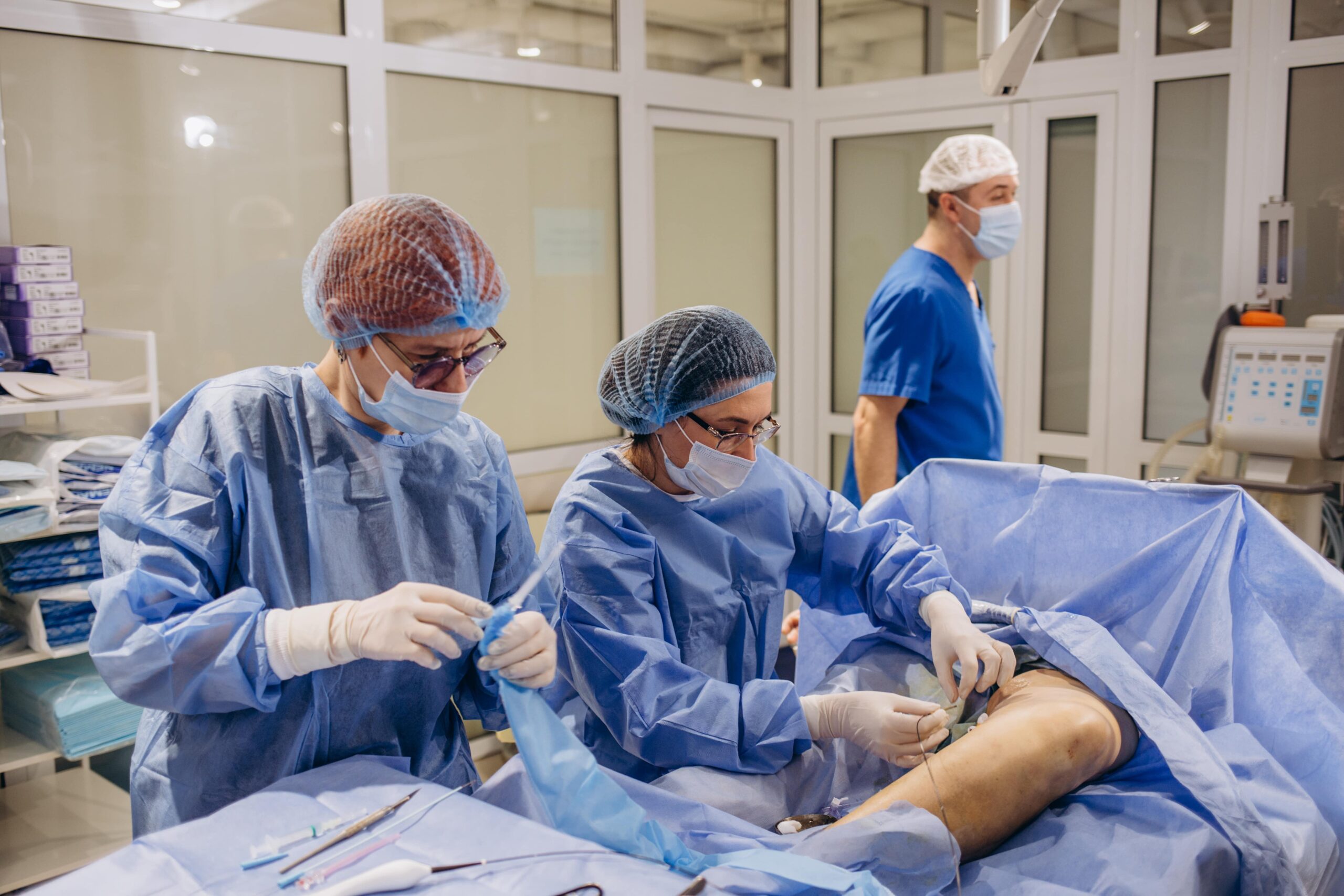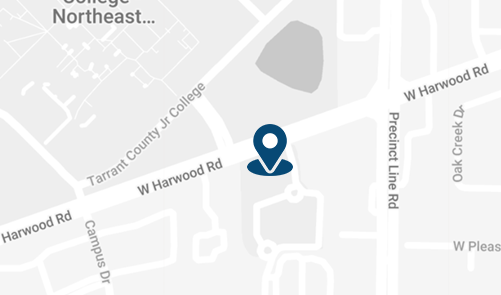By: Dr. Dev Batra | 11.15.25
Highlights
- Embolization procedures offer non-surgical relief for knee pain, heel pain, and fibroids with minimal downtime.
- GAE targets knee inflammation from osteoarthritis, helping patients avoid knee replacement surgery.
- PFE reduces chronic heel pain by decreasing blood flow to inflamed plantar fascia tissue.
- UFE shrinks uterine fibroids naturally while preserving the uterus and avoiding hysterectomy.
- Texas Vascular Institute uses advanced imaging technology to deliver precise, patient-centered embolization treatments.
Pain shouldn’t control your life. Whether it’s the daily struggle of climbing stairs with aching knees, the sharp stab of heel pain with every step, or the heavy bleeding and discomfort from uterine fibroids – chronic conditions have a way of taking over.
For years, many of these issues meant facing invasive surgery, lengthy recovery times, and uncertain outcomes. But what if there was another option?
Embolization procedures are changing the way we treat chronic pain and conditions like knee osteoarthritis, plantar fasciitis, and uterine fibroids. These minimally invasive treatments target the root cause of your symptoms without the need for traditional surgery, offering relief with faster recovery and less risk.
In this post, we’ll walk you through what embolization is, how it works, and which conditions it can help treat so you can make an informed decision about your care.
What Is Embolization?
Embolization is a minimally invasive procedure that blocks blood flow to specific areas causing inflammation and pain. By cutting off the blood supply to problem areas, embolization helps reduce symptoms, shrink growths, and promote healing – all without traditional surgery.
How Embolization Works
The procedure is performed by an interventional radiologist using advanced imaging technology. Here’s how it works:
Step 1: A small catheter is inserted
Using image guidance, your doctor inserts a thin, flexible catheter into a blood vessel, typically through a tiny puncture in your wrist or groin.
Step 2: Tiny particles are delivered
The catheter is carefully guided to the blood vessels feeding the problem area. Once in place, tiny embolic particles are released to block blood flow.
Step 3: Relief begins
With the blood supply reduced or cut off, inflammation decreases, abnormal tissue shrinks, and symptoms improve over the following weeks.

Benefits of Embolization Procedures
- Non-surgical: No large incisions, no general anesthesia, and no lengthy hospital stays.
- Outpatient procedure: Patients go home the same day.
- Minimal recovery time: Return to normal activities much faster than with traditional surgery.
- Lower risk: No incisions and no general anesthesia = fewer complications compared to invasive surgical options.
- Targeted treatment: Precisely addresses the source of your symptoms without affecting surrounding healthy tissue.
Now let’s look at the specific embolization procedures that are transforming treatment for knee pain, heel pain, and uterine fibroids.
Types of Embolization Procedures
Genicular Artery Embolization (GAE) – Non-Surgical Knee Pain Relief
If you’ve been living with chronic knee pain from osteoarthritis, you know how it limits everything – from walking and exercising to simply getting through your day without discomfort.
Genicular Artery Embolization (GAE) is a groundbreaking treatment that targets the inflammation driving your knee pain, offering relief without the need for knee replacement surgery.
How GAE Works
Knee osteoarthritis causes inflammation in the lining of your joint, which creates pain and stiffness. GAE blocks the tiny blood vessels feeding this inflamed tissue, reducing both the inflammation and the pain signals it generates.
During the procedure, your interventional radiologist uses real-time imaging to guide a catheter to the genicular arteries around your knee. Small embolic particles are then released to reduce blood flow to the inflamed areas.
Benefits of GAE:
- Significant pain reduction: Many patients report noticeable improvement within weeks.
- Improved mobility: Less pain means better range of motion and easier movement.
- Avoid knee replacement: GAE offers an alternative for patients who aren’t ready for or don’t qualify for joint replacement surgery.
- Quick recovery: Most patients return to light activities within days.
For patients with chronic knee pain solutions who’ve tried physical therapy, injections, and medications without lasting relief, GAE represents a new path forward.

Plantar Fasciitis Embolization (PFE) – Non-Surgical Heel Pain Treatment
Chronic heel pain from plantar fasciitis can make every step feel like walking on broken glass. When stretching, orthotics, and other conservative treatments haven’t worked, you might think surgery is your only option.
Plantar Fasciitis Embolization (PFE) offers a less invasive alternative that targets the root cause of your pain.
How PFE Works
Chronic plantar fasciitis involves persistent inflammation in the thick band of tissue (plantar fascia) running along the bottom of your foot. This inflammation is fed by tiny blood vessels that keep the cycle of pain going.
PFE reduces blood flow to these inflamed areas, breaking the cycle and allowing your body to heal. Using the same minimally invasive approach as other embolization procedures, your doctor guides a catheter to the small arteries feeding the plantar fascia and delivers embolic particles to reduce inflammation.
Benefits of PFE
- Reduced inflammation: Less blood flow means less inflammatory response and decreased pain.
- Faster recovery than surgery: Most patients experience significantly less downtime than with traditional plantar fasciitis surgery.
- Return to activity: Get back to walking, running, and daily activities without constant heel pain.
- High success rate: Studies show promising results for patients with chronic, treatment-resistant plantar fasciitis.
Uterine Fibroid Embolization (UFE) – Fibroid Treatment Without Surgery
Uterine fibroids affect millions of women, causing heavy menstrual bleeding, pelvic pressure, frequent urination, and pain that disrupts daily life. For years, hysterectomy was considered the definitive solution – but it’s not the only one.
Uterine Fibroid Embolization (UFE) is a proven, minimally invasive treatment that shrinks fibroids and relieves symptoms while preserving your uterus.
How UFE Works
Fibroids are non-cancerous growths in the uterus that depend on blood supply to survive and grow. UFE blocks the arteries feeding these fibroids, cutting off their blood supply and causing them to shrink naturally over time.
During the procedure, your interventional radiologist accesses the uterine arteries through a small catheter and delivers embolic particles that block blood flow specifically to the fibroids. The surrounding healthy uterine tissue maintains its normal blood supply.
Benefits of UFE
- Avoids hysterectomy: Keep your uterus while still achieving effective fibroid symptom relief.
- Treats multiple fibroids at once: UFE works on all fibroids simultaneously, regardless of size or location.
- Preserves fertility options: Many women maintain their ability to conceive after UFE.
- Short recovery period: Most patients return to normal activities within 1-2 weeks, compared to 6-8 weeks for hysterectomy.
- High satisfaction rate: Studies show over 90% of patients experience significant symptom improvement.
For women seeking fibroid treatment without surgery, UFE offers an effective, uterus-sparing alternative that addresses heavy bleeding, pelvic pain, and bulk symptoms.

Why Choose Embolization at Texas Vascular Institute
When it comes to minimally invasive embolization and interventional radiology procedures, expertise and experience matter.
Board-Certified Interventional Radiologists
At Texas Vascular Institute, our team of board-certified interventional radiologists specializes in image-guided procedures that offer alternatives to traditional surgery. Dr. Dev Batra and our experienced physicians have performed thousands of embolization procedures with consistently positive outcomes.
State-of-the-Art Technology
We use the latest imaging technology and minimally invasive tools to ensure precision and safety during every procedure. Our advanced equipment allows us to visualize blood vessels in real-time, delivering treatment exactly where it’s needed while protecting surrounding healthy tissue.
Convenient Locations
With offices in Dallas, Hurst, and Plano, Texas Vascular Institute makes it easy to access world-class vascular treatments without traveling far from home.
Patient-Centered Care
We understand that every patient is unique. That’s why we create personalized treatment plans based on your specific condition, symptoms, and goals. From your initial consultation through recovery and follow-up, we’re with you every step of the way.
Our comprehensive approach means:
- Thorough diagnostic imaging to understand your condition
- Clear explanation of your treatment options
- Realistic expectations about outcomes and recovery
- Ongoing support throughout your healing process
- Long-term follow-up to ensure lasting results
- Proven outcomes
Our patients consistently report significant symptom improvement and high satisfaction with their embolization procedures. We’re proud to maintain a 5-star rating across hundreds of patient reviews, reflecting our commitment to exceptional care and results.

FAQs About Embolization
How long does an embolization procedure take?
Most embolization procedures take 45-90 minutes, depending on the complexity and type of treatment. You’ll spend additional time in preparation and recovery, but patients go home the same day.
Is embolization painful?
The procedure itself is performed under local anesthesia with sedation, so you shouldn’t feel pain during treatment. Some patients experience mild discomfort or soreness afterward, which typically resolves within a few days and can be managed with over-the-counter pain medication.
How soon will I see results?
Results vary by procedure type. GAE and PFE patients often notice pain improvement within 2-4 weeks, with continued improvement over several months. UFE patients typically see symptom relief within 2-3 months as fibroids shrink.
What’s the recovery time for embolization?
Most patients return to light activities within a few days and normal activities within 1-2 weeks. This is significantly faster than traditional surgery, which may require 6-8 weeks of recovery.
Are embolization procedures covered by insurance?
Many insurance plans cover embolization procedures, including GAE, PFE, and UFE. Our team will work with your insurance provider to verify coverage and discuss your options during your consultation. See the complete list of insurance providers we accept.
Take the First Step Toward Relief
Embolization procedures like GAE, PFE, and UFE are transforming how we treat chronic knee pain, heel pain, and uterine fibroids. These minimally invasive treatments offer real relief with less risk, faster recovery, and better outcomes than many traditional surgical options.
If you’re struggling with knee osteoarthritis, plantar fasciitis, or fibroid symptoms and want to explore pain relief without surgery, Texas Vascular Institute can help.
Schedule a consultation to discuss whether embolization is right for you. Our team will evaluate your condition, answer your questions, and create a personalized treatment plan designed to help you get back to living your life – without pain holding you back.
Ready to refer a patient? Healthcare providers can submit a referral online or contact our office directly.
Read more blogs
Embolization Procedure
Discover embolization procedures for non-surgical relief from knee pain, heel pain, and fibroids. Safe, effective, and fast recovery.
Find Relief Without Surgery
Find relief without surgery at Texas Vascular Institute. Minimally invasive vascular treatments, faster recovery, and compassionate care.
Uterine Fibroid Embolization
Learn how Uterine Fibroid Embolization (UFE) treats fibroids safely without surgery. Discover benefits, recovery, and if it’s right for you.
WHAT OUR PATIENTS
have to say
Texas Vascular Institute always appreciates feedback from our valued patients. To date, we’re thrilled to have collected 378 reviews with an average rating of 5 out of 5 stars. Please read what others are saying about Texas Vascular Institute below, and as always, we would love to collect your feedback.
Leave a Review
Amazing Practice
I'm very particular with my Healthcare and tend to be cautious with referrals to specialists. This office is amazing from the first point of contact. Their staff are friendly, professional and highly knowledgeable. Then the Dr is just as amazing as his staff, absolutely brilliant. Office manager Jessica has this office running like a well oiled machine and does so with a smile, an air of confidence, kindness and professionalism. Love this practice!!
- Richard G.

Beyond Thankful
Dr Batra and his staff are amazing! We are so grateful to have found him. Everyone is so kind and so caring and Dr Batra explains everything so well and does procedures with excellence. Beyond thankful to be under their care!!!
- Bitsy P.

Gold Standard
This is a gold standard for how a medical practice should be run. I was promptly seen at my scheduled time, my ultrasound was thorough and I received plenty of attention and care from the staff and Dr.Batra.
- Weronika L.
INSURANCE
We accept most major insurance plans. Please contact the medical office for all insurance related questions.









8330 Meadow Rd #100
Dallas, TX 75231
For Appointments: 972-798-4710
General Inquiries: 972-646-8346

809 West Harwood Rd, Suite 101,
Hurst, TX 76054
For Appointments: 972-798-4710
General Inquiries: 972-646-8346

4716 Alliance Blvd Suite #180,
Plano, TX 75093
For Appointments: 972-798-4710
General Inquiries: 972-646-8346

